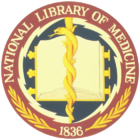United States National Library of Medicine
The United States National Library of Medicine (NLM), operated by the United States federal government, is the world's largest medical library.[1] The collections of the National Library of Medicine include more than seven million books, journals, technical reports, manuscripts, microfilms, photographs, and images on medicine and related sciences, including some of the world's oldest and rarest works.
Since 1879, the NLM has published the Index Medicus, a monthly guide to articles in nearly five thousand selected journals. The last issue of Index Medicus was printed in December 2004, but this information is offered in the freely accessible PubMed amongst the more than fifteen million MEDLINE journal article references and abstracts going back to the 1960s and 1.5 million references going back to the 1950s.
The NLM also runs the National Center for Biotechnology Information (NCBI) which houses biological databases freely accessible over the Internet through the Entrez search engine and PubMed.
The Toxicology and Environmental Health Program (TEHIP), established at the NLM in 1967, is charged with developing computer databases compiled from the medical literature and from the files of governmental and nongovernmental organizations.[2] TEHIP has implemented several information systems for chemical emergency response and public education, such as the Toxicology Data Network (TOXNET), TOXMAP, Tox Town, Wireless Information System for Emergency Responders (WISER), Toxmystery, and the Household Products Database. These resources are accessible without charge on the Web.
The Extramural Programs Division provides grants to support research in medical information science and to support planning and development of computer and communications systems in medical institutions. Research and publications in the history of medicine and the life sciences are also supported.
History
- For details of the pre-1956 history of the Library, see Library of the Surgeon General's Office.
The precursor of the NLM, established in 1836, was the Library of the Surgeon General's Office, a part of the office of the U.S. Army Surgeon General. The Armed Forces Institute of Pathology and its Medical Museum were founded in 1862 as the Army Medical Museum. Throughout their history the Army Medical Library and the Army Medical Museum often shared quarters. From 1866 to 1887, they were housed in Ford's Theatre after production there was stopped after the assassination of President Abraham Lincoln.
In 1956, the Library collection was transferred from the control of the U.S. Department of Defense to the Public Health Service of the Department of Health, Education and Welfare and renamed the National Library of Medicine. The Library moved to its current quarters in Bethesda, Maryland, on the campus of the National Institutes of Health, in 1962.
See also
- HubMed
- National Library of Medicine classification system
ReferencesISBN links support NWE through referral fees
- Miles, Wyndham D., A History of the National Library of Medicine: The Nation's Treasury of Medical Knowledge; U. S. Government Printing Office, 1992.
Footnotes
- ↑ DeBakey ME (1991). The National Library of Medicine. Evolution of a premier information center. JAMA 266 (9): 1252-8.
- ↑ Toxicology and Environmental Health Program. Retrieved 2007-07-11.
External links
- Official homepage
- MEDLINE/PubMed
- MedlinePlus.gov
- ClinicalTrials.gov Developed to provide information about clinical research
- AIDSinfo.nih.gov A comprehensive resource providing HIV/AIDS treatment and clinical trial information
| |||||||||||
Credits
New World Encyclopedia writers and editors rewrote and completed the Wikipedia article in accordance with New World Encyclopedia standards. This article abides by terms of the Creative Commons CC-by-sa 3.0 License (CC-by-sa), which may be used and disseminated with proper attribution. Credit is due under the terms of this license that can reference both the New World Encyclopedia contributors and the selfless volunteer contributors of the Wikimedia Foundation. To cite this article click here for a list of acceptable citing formats.The history of earlier contributions by wikipedians is accessible to researchers here:
The history of this article since it was imported to New World Encyclopedia:
Note: Some restrictions may apply to use of individual images which are separately licensed.
